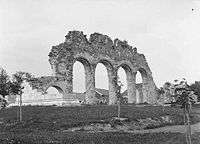Cathedral Ruins in Hamar
For the current cathedral in Hamar, see Hamar cathedral.

Axel Lindahl, 1890s

Olaf Nordhagen
Hamar Cathedral was the see of the Ancient Diocese of Hamar. The diocese at Hamar had included much of the (modern) counties of Hedmark, Oppland, and Buskerud.[1]
The cathedral's construction was begun by Bishop Arnaldur (1124–52), who was appointed first Bishop of Hamar in 1150 on his return from Gardar, Greenland. The cathedral was completed about the time of Bishop Paul (1232–52). It was originally built in the Romanesque architectural style and later converted to Gothic. Bishop Thorfinn of Hamar (1278–82) was exiled and died at Ter Doest in Flanders. Thorfinn and many other bishops of the area disagreed with King Eric II of Norway regarding a number of issues, including episcopal elections. Bishop Jörund (1285–86) was transferred to Trondheim.
In the aftermath of the Reformation in Norway the structure was renamed Hamarhus fortress and became the residence of the sheriff. Although still used, the cathedral fell into disrepair, which culminated with its besiegement by the Swedish army and attempted demolition in 1567 during the Northern Seven Years' War. Swedish forces had launched attacks into Eastern Norway, capturing Hamar and continued towards Oslo. The Swedes later retreated, torching Hamar on their way, destroying Hamar Cathedral and Hamarhus.[2]
Today the ruins of Hamar Cathedral are part of Hedmark museum (Hedmarksmuseet). The distinctive arches of the cathedral ruins are today protected by one of the most ambitious construction projects of its kind ever undertaken by the Norwegian government.[3] The ruins were selected as the millennium site for Hedmark county.
Gallery
 Arches in the Cathedral Ruins
Arches in the Cathedral Ruins Arches in the Cathedral Ruins
Arches in the Cathedral Ruins Arches in the Cathedral Ruins
Arches in the Cathedral Ruins Arches in the Cathedral Ruins
Arches in the Cathedral Ruins
References
Other sources
- Brunsvik, Hilde En guide til Oslo domkirke (2003)